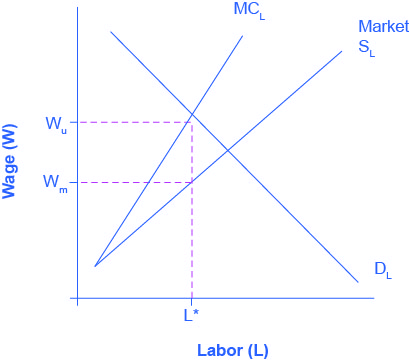Part 14: Labor Markets and Income
14.4 Bilateral Monopoly
Learning Objectives
By the end of this section, you will be able to explain:
- How firms determine wages and employment when a specific labor market combines a union and a monopsony
Introduction
What happens when there is market power on both sides of the labor market, in other words, when a union meets a monopsony? Economists call such a situation a bilateral monopoly.

(Figure) is a combination of Figure 14.6 and Figure 14.11. A monopsony wants to reduce wages as well as employment, Wm and L* in the figure. A union wants to increase wages, but at the cost of lower employment, Wu and L* in the figure. Since both sides want to reduce employment, we can be sure that the outcome will be lower employment compared to a competitive labor market. What happens to the wage, though, is based on the monopsonist’s relative bargaining power compared to the union. The actual outcome is indeterminate in the graph, but it will be closer to Wu if the union has more power and closer to Wm if the monopsonist has more power.
Key Concepts and Summary
A bilateral monopoly is a labor market with a union on the supply side and a monopsony on the demand side. Since both sides have monopoly power, the equilibrium level of employment will be lower than that for a competitive labor market, but the equilibrium wage could be higher or lower depending on which side negotiates better. The union favors a higher wage, while the monopsony favors a lower wage, but the outcome is indeterminate in the model.
Review Questions
What is a monopsony?
What is the marginal cost of labor?
How does monopsony affect the equilibrium wage and employment levels?
What is a bilateral monopoly?
How does a bilateral monopoly affect the equilibrium wage and employment levels compared to a perfectly competitive labor market?
Glossary
- bilateral monopoly
- a labor market with a monopsony on the demand side and a union on the supply side

